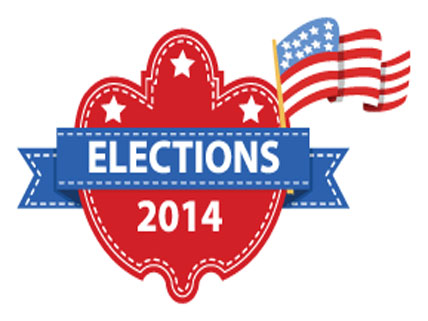Election Day 2014 is just five months away. Considered a “midterm” election because it occurs between presidential years, the vote will feature 33 US Senate races and 36 contests for state governor. The entire House of Representatives is up for grabs, as it is every two years.
The Republicans’ current House majority is unlikely to change. The 100-member Senate is where the action is. The Democrats currently hold 53 Senate seats to 45 for the Republicans (2 senators are Independent who “caucus” with the Democrats). In addition to the seats regularly up for election, three special elections are being held (in Hawaii, Oklahoma, and South Carolina) to fill seats vacated by retirement. Of the 33 Senate seats in play, most political observers consider 6 to be safe Democratic seats and 11 to be safe for the Republicans. (A “safe” seat is one that is very likely to be won by either the current officeholder or a candidate of the incumbent’s same party.) About a dozen Senate races are expected to be fairly close. Like “swing states” during a presidential election, the “toss-up” contests—in Alaska, Arkansas, Colorado, Georgia, Iowa, Kentucky, Louisiana, and North Carolina—will decide whether Democrats will maintain their present majority. The Republican Party must gain a net of six seats to “take the Senate.”
The elections in 2014 mark the 100th year that senators have been elected by popular vote. Direct election was the result of the Seventeenth Amendment, passed in 1913. According to the US Constitution as originally written, senators were selected by the legislatures of their home states.
Of the governor’s mansions at stake, most stand little chance of being won by challengers. Florida, Georgia, Iowa, New Mexico, Oregon, Pennsylvania, and Wisconsin will witness a close gubernatorial (i.e., governor’s) race. Of the gubernatorial candidates, 21 are Republicans running for reelection, and 8 are Democratic incumbents seeking to return to office. In six states, the present governors are retiring or must step down due to term limits.
Image credit: © VectorShots/Shutterstock
Related Links
- Election 2014
This website reports stories related to the upcoming “midterm” elections for the Senate, House of Representatives, and governorships; includes polling data and nationwide perspectives on Senate and governors’ races.
(Source: Real Clear Politics; accessed May 31, 2014) - United States Senate Elections, 2014
This article presents a straightforward picture of the 2014 Senate midterms.
(Source: Wikipedia; accessed May 31, 2014) - United States Gubernatorial Elections, 2014
Likewise, what’s at stake nationwide in the 2014 governor’s races.
(Source: Wikipedia; accessed May 31, 2014) - United States House of Representatives Elections, 2014
This website is a clearinghouse for electoral politics; this page covers the upcoming midterm elections for the lower house of Congress.
(Source: Ballotpedia; accessed May 31, 2014) - Direct Election of Senators
Read about the history of the direct election of senators, which was instituted by the Seventeenth Amendment in 1913.
(Source: accessed May 31, 2014)





summary write summary’s
I think another thing worth meninoting is the proportion of non-Conservative voters to Conservative voters that have shown up (in my calculation) from the numbers Dave has provided:2004 non/Con = 61%2006 non/Con = 53%2008 non/Con = 53%Ever since the Conservative party has secured its representation in Alberta by riding the vote split on the left, it seems as though fewer non-Conservative voters have been showing up to the polls. My explanation is despair as a product of disempowerment.The only explanation I have for the proportion staying the same in 2006 and 2008, and the other variable of decreased voter turnout other than increased apathy, is Conservative arrogance and non-Conservative despair.